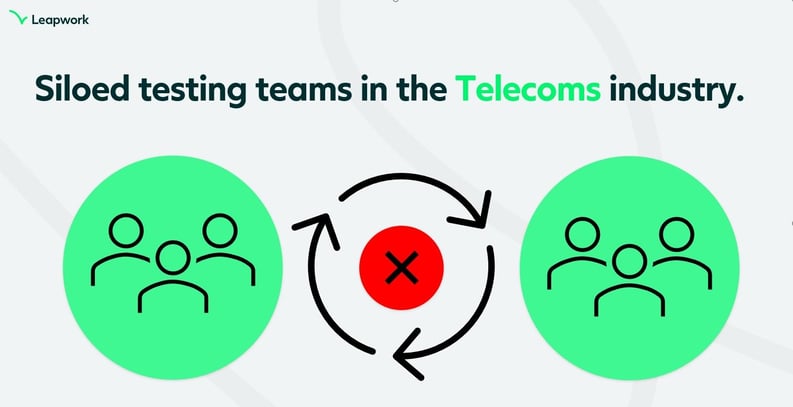Telecom Testing in 2024: An Introduction to Test Automation
Customer behavior has been heavily disrupted. The worldwide pandemic has forced the Telecoms industry to make changes in record time while testing teams have been putting down fires left and right.
Even though digital transformation was already a strategic priority in this industry, COVID-19 has amplified its importance and showcased the benefits.
Now more than ever it is of utmost importance to improve customer experience by providing a seamless, digital omnichannel experience. This is achieved by giving the existing siloed, decoupled business system infrastructure a much-needed upgrade: a replacement.
Unfortunately, this is much easier said than done. More on this below.
Why is testing important for Telecoms?
The rising digitalization of services means that customers now expect immediate personalized services in real-time. The “right here, right now” experience is at its peak.
However, the way telecom enterprises operate IT is too complex, thus obstructing digital maturity. Their monolithic legacy systems don’t offer an innovative and seamless experience for customers.
According to a report by TM Forum, ‘inflexible legacy IT technology’ was ranked as the number one barrier to digital transformation.
So how do you maintain business continuity while transforming decoupled and siloed customer channels into omnichannel systems?
Business Support System (BSS) digital transformation is not a one-time occurrence, it is a long and continuous journey that needs close monitoring from all different angles.
Testing ensures that all those business-critical systems and processes are working as intended. The most common processes under test in the Telecoms industry are:
- CRM & ERP
- Order and fraud management
- Customer case
- Network management
- Mediation
- Provisioning
- EAI
- Billing
- Revenue assurance
- Data warehousing
What are the challenges in software testing for telcos?
Telcos’ monolithic core IT systems are a true challenge for QA teams. Testers must anticipate end-user behavior and balance that against requirements for each business domain. This means creating strategies that cover as much of the product as possible under time and budget constraints.
Moreover, due to this complex maze of legacy systems and processes, most telcos have different teams working on and testing the different business domains. This translates into siloed testing teams that lack communication and collaboration between them.

These teams are mainly testing the functionality of each of the systems that are involved in those business processes, but they are not testing the business processes from the end user's perspective. This approach not only puts the user’s omnichannel experience at risk but also business continuity, resulting in catastrophic financial losses.
What is Telco automation in software testing?
The overly complex infrastructure in the Telecoms industry, combined with an extensive business scope by nature, means that manual testing quickly piles up and becomes unmanageable. As the transformation in itself is already an enduring undertaking, all actions that can reduce this process must be considered.
Automating the test of an extensive software replacement is an obvious place to look. Test automation increases agility, efficiency, and test coverage. These, in turn, decrease the length of the test cycle while improving the quality of a business’s digital ecosystem, hence shortening the time to market.
For example, a Telecoms company could be making some of their broadband service diagnostic platform available online to diagnose and resolve service issues quickly. Testing this system and its integrations is paramount for customer satisfaction and business retention. However, if bugs are not identified and resolved quickly enough the business’ reputation could be damaged. Automation, on the other hand, would allow for quicker detection and resolution, therefore decreasing customer churn.
However, currently, most test automation tools available in the market are developed with a “programming mindset”, meaning that even those tools that claim to be codeless, still require testers to know code, to some extent.
The problem is that code-based automation doesn't help to solve the communication issue that telecoms' testing teams experience. If so, it only aggravates the problem. This is because only a select group of professionals can build automation; those with programming experience.
Programmers are an expensive resource that, for a significant proportion of businesses, are lacking in the QA domain. This creates a dependency between testers and developers that results in one extra layer of complexity.
If we want to develop efficient end-to-end testing we must find a solution that facilitates collaboration between testing teams.
No-code automation tools, on the other hand, are a better option for telcos due to their collaborative and business-centric nature.
How does no-code automation fit into telecom software testing?
Removing programming knowledge from the equation means that more people, with each of their diverse sets of skills - from development, data, testing, application, and business - can work seamlessly together to build automation. For rapid, scalable, end-to-end test automation that breaks down silos and delivers immediate results.
Recommended Reading: Collaboration in Agile Teams: Codeless Automation For All
From the perspective of the business owner, this presents a more accessible automation opportunity. It creates a shift from a technology-only driven approach, focusing on frameworks, technologies, and atomic objects requiring code to operate, towards a business task-driven one, where the understanding of business processes, rules, and application is the centerpiece.
Essentially, this new approach shifts the skills and competence requirements behind automation. Additional roles and skill sets become available and relevant for successful automation. And, more importantly, it makes automation possible without being fully dependent on developer resources.
This is a crucial differentiator because the skills and competence that are necessary for code-based automation are indeed the main impediments preventing organizations from getting truly effective, operational, and scalable automation up and running.
What should telcos consider before adopting automation?
The choice of applying a business-centric approach to automation should not mean businesses have to compromise on the capabilities of automation. When assessing the options for automation, care must be taken to ensure the validation of:
- True cross-functional coverage: Business verticals within the organization (Sales, manufacturing, resource management, warehouse and logistics, etc.)
- Cross-technology support: Web, desktop-based, virtual, and legacy applications.
- End-to-end coverage: This is especially relevant in the context of telcos, considering the heterogeneous application landscape.
- Advanced capabilities related to data parameterization, processing, and even transformation.
With these capabilities in place, and available in a codeless and business user-oriented way, automated validation of any business process in the BSS context is available and should be incorporated into the transformation timeline.
The ability to incorporate and ultimately assign automation ownership to the business resources will significantly improve the ability to employ automation without the traditional compromise towards delivery capability.


